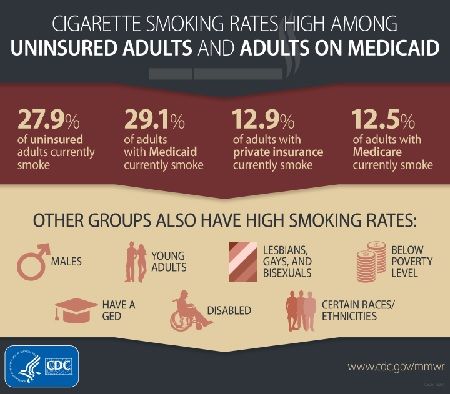Article
Smoking Rates Declining but Disparities Evident: CDC Report
Author(s):
According to the CDC, while smoking rates are seeing a steady decline, rates for uninsured and adults on Medicaid are more than twice those for adults with private health insurance.
Whether you are privately or federally insured is an important determinant of whether you smoke, according to CDC’s Morbidity and Mortality Weekly Report released today.
Results based on the 2014 National Health Interview Survey show that 27.9% of uninsured adults and 29.1% of Medicaid enrollees smoke, compared with 12.9% of privately insured adults and 12.5% of Medicare enrollees who are smokers. Another important finding, other than the insurance-based disparity, is the steady decline in the rate of smoking over a decade (2005 to 2014), from 20.9% to 16.8%—these numbers seem well on target to achieving a smoking rate of 12% or lower by 2020, per the Healthy People 2020 targets. The average number of cigarettes smoked per day dropped by about 3 percentage points, from 16.7% to 13.8% during the study period.
The highest smoking rates were observed among:
· Males
· Young adults
· People below the poverty line
· People with a disability
· People with a General Education Development certificate
· People who are lesbian, gay, or bisexual.

Source: CDC
A press release announcing the results of the study, from the Campaign for Tobacco-Free Kids, says that while the results prove that the fight against this devastating habit has made huge strides, there’s much work needed to meet the goals of “protecting Americans from the number one cause of preventable death.” The organization urges continued national efforts on multiple fronts, including higher taxation on tobacco products, smoke-free laws, and barrier-free health insurance for smoking cessation treatments, among others.
Smoking cessation treatments have gained improved coverage, especially under the Affordable Care Act. A recent report by the CDC, addressing cessation coverage, found that only 9 states cover all 9 evidence-based cessation treatments (individual counseling, group counseling, nicotine gum, nicotine patches, nicotine lozenge, nicotine nasal spray, nicotine inhaler, bupropion, and varenicline).
Praising the findings from the report, CDC Director Tom Frieden, MD, MPH, said, “Smoking kills half a million Americans each year and costs more than $300 billion. This report shows real progress helping American smokers quit and that more progress is possible.”




